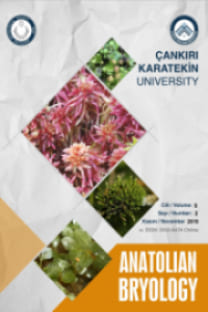Bazı Bryaceae (Bryophyta) Türlerinin Glutatyon İçeriklerinin Karşılaştırılması
Bu çalışmada, Bryum argenteum, Imbribryum mildeanum, Ptychostomum imbricatulum (I, II), Ptychostomum moravicum (I, II, III) ve Ptychostomum capillare türlerindeki okside glutatyon (GSSG) ile redükte glutatyon (GSH) miktarları Yüksek Performanslı Sıvı Kromatografisi (HPLC) cihazıyla belirlenmiştir. Türlerin GSH ve GSSG miktarları sırasıyla; Bryum argenteum 232.70 ± 13.40 µg/g ve 4,22 ± 1.20 µg/g; Imbribryum mildeanum 135.55 ± 6.66 µg/g ve 26.97 ± 2.50 µg/g; Ptychostomum imbricatulum (I) 107.44 ± 8.71 µg/g ve 153.05 ± 9.85 µg/g; Ptychostomum imbricatulum (II) 207.97 ± 13.58 µg/g ve 107.67 ± 4.55 µg/g; Ptychostomum moravicum (I) 172.89 ± 6.35 µg/g ve 12.53 ± 2.59 µg/g; Ptychostomum moravicum (II) 172.15 ± 6.62 µg/g ve 20.48 ± 2.54 µg/g; Ptychostomum moravicum (III) 176.84 ± 6.49 µg/g ve 28.86 ± 4.59 µg/g ve Ptychostomum capillare 234.38 ± 5.79 µg/g ve 6.58 ± 1.91 µg/g olarak belirlenmiştir. Bu sonuçlar, Bryaceae familyasına ait bu türlerin, Glutatyon (GSH ve GSSG) miktarları bakımından çok iyi birer kaynak olduklarını göstermiştir. Yüksek glutatyon içeriklerinden dolayı bu familya ve türlerinin, antioksidan özellikte bitkiler oldukları ve çeşitli alanlarda ham madde kaynağı olarak kullanılabilecekleri sonucuna varılmıştır.
Comparing of Glutathione Ingredients of Some Bryaceae (Bryophyta) Species
In this study, Reduced Glutathione (GSH) and Oxidized Glutathione (GSSG) levels of Bryum argenteum, Imbribryum mildeanum, Ptychostomum imbricatulum (I, II), Ptychostomum moravicum (I, II, III) and Ptychostomum capillare were determined with High-performance Liquid Chromatography (HPLC). GSH and GSSG levels of species were determined as Bryum argenteum 232.70 ± 13.40 µg/g ve 4,22 ± 1.20 µg/g; Imbribryum mildeanum 135.55 ± 6.66 µg/g ve 26.97 ± 2.50 µg/g; Ptychostomum imbricatulum (I) 107.44 ± 8.71 µg/g ve 153.05 ± 9.85 µg/g; Ptychostomum imbricatulum (II) 207.97 ± 13.58 µg/g ve 107.67 ± 4.55 µg/g; Ptychostomum moravicum (I) 172.89 ± 6.35 µg/g ve 12.53 ± 2.59 µg/g; Ptychostomum moravicum (II) 172.15 ± 6.62 µg/g ve 20.48 ± 2.54 µg/g; Ptychostomum moravicum (III) 176.84 ± 6.49 µg/g ve 28.86 ± 4.59 µg/g ve Ptychostomum capillare 234.38 ± 5.79 µg/g ve 6.58 ± 1.91 µg/g respectively. These results showed that these bryophyte species belonging to the Bryaceae family are very good sources of glutathione (GSH and GSSG). Due to their high glutathione content, it has been concluded that the family and species are antioxidant plants and can be used as raw material in various fields.
___
- Abay G. 2006. Briyofitlerin Kullanım Alanları, Ekolojik ve Ekonomik Önemi. I. Uluslararası Odun Dışı Orman Ürünleri Sempozyum Bildiriler Kitabı. Trabzon.
- Abay G. Kamer D. 2010. Biyoçeşitliliğimizin Az Bilinen Bileşenleri ‘Briyofitler’. III. Ulusal Karadeniz Ormancılık Kongresi. 3, 1115-1125.
- Akkuş İ. 1995. Serbest Oksijen Radikalleri ve Fizyopatolojik Etkileri. Mimoza Basım Yayın ve Dağıtım. Konya.
- Basile A. Giardano S. López-Sáez J.A. Cobianchini C.R. 1999. Antibacterial Activity of Pure Flavonoids Isolated From Mosses. Phytochemistry. 52, 1479-1482.
- Baytop T. 1984. Türkiye’de Bitkiler ile Tedavi (Geçmişte ve Bugün). İstanbul Üniversitesi Yayınları. İstanbul.
- Büyük İ. Soydam A. Aras S. 2012. Bitkilerin Stres Koşullarına Verdiği Moleküler Cevaplar. Türk Hijyen ve Deneysel Biyoloji Dergisi. 69:2, 97-110.
- Cangül C. 2010. Kaplandede Dağının Bryofit Florası (Düzce). Niğde Ömer Halisdemir Üniversitesi Fen Bilimleri Enstitüsü. Niğde.
- Cheeseman K.H. Slater T.F. 1993. An Introduction to Free Radical Biochemistry. Br. Med. Bull. 49:3, 479- 480.
- Çöteli E. Alataş M. Batan N. 2017. Syntrichia ruralis ve Syntrichia montana (Pottiaceae) Taksonlarının Glutatyon İçeriklerinin Karşılaştırılması. Anatolian Bryology. 3:1, 25-30.
- Dawes P. Dawes E. 2000. SGE Chromatography Products Catalog. s. 182.
- Dündar Y. Aslan R. 1999. Oksidan-Antioksidan Denge ve Korunmasında Vitaminlerin Rolü. Hayvancılık Araştırma Dergisi. 9:1- 2, 32-39.
- Elibol B. 2010. Bazı Akrokarpik Karayosunlarının Antifungal ve Antibakteriyel Etkilerinin Belirlenmesi. Niğde Ömer Halisdemir Üniversitesi Fen Bilimleri Enstitüsü. Niğde.
- Glime J.M. Saxena D.K. 1990. Uses of Bryophytes. Today and Tomorrow Printers and Publishers. New Delhi.
- Jimenez A. Hernandez J.A. Pastori G. del Rio L.A. Sevilla F. 1998. Role of the Ascorbate-Glutathione Cycle of Mitochondria and Peroxisomes in the Senescence of Pea Leaves. Plant Physiol. 118: 1327-35.
- Karabulut H. Gülay M.Ş. 2016. Serbest Radikaller. Mehmet Akif Ersoy Üniversitesi Sağlık Bilimleri Enstitüsü Dergisi. 4:1, 50-59.
- Kidd P.M. 1997. Glutathione: Systemic Protectant Against Oxidative and Free Radical Damage. Alternative Medicine Reviews. 2: 155-176.
- Nelson D.L. Cox M.M. 2000. Lehninger, Principles of Biochemistry 3rd Ed. Worth Publishing. New York.
- Onat T. Emerk K. Sözmen E.Y. 2002. İnsan Biyokimyası. Yaşlanma Biyokimyası. Sözmen E.Y. Editor(s). Palme Yayıncılık. Ankara.
- Rausch T. Wachter A. 2005. Sulfur Metabolism: A Versatile Platform for Launching Defence Operations. Trends Plant Sci. 10: 503-9.
- Shibata H. Sasaki N. Hondjoh T. Ohishi I. Takiquchi M. Ishioka K. Ahmed M. Soliman M. Kimura K. Saito M. 2003. Feline Leptin: Immunogenic and Biological Activities of the Recombinant Protein and Its Measurement by ELISA. J Vet Med Sci. 65: 1207-1211.
- Türkyılmaz Ünal B. İşlek C. Ezer T. Düzelten Z. 2017. Allelopathic Effects of Cinclidotus pachylomoides (Bryophyta) on Pepper and Corn Plants. Anatolian Bryology. 3:2, 58-67.
- URL1. Bryum mildeanum. 2018. Website: http://eecodb.bas.bg/rdb/en/vol1/Brymilde.html, [Erişim: 15 Ekim 2018].
- ISSN: 2149-5920
- Yayın Aralığı: Yılda 2 Sayı
- Başlangıç: 2015
- Yayıncı: Çankırı Karatekin Üniversitesi
Sayıdaki Diğer Makaleler
Çankırı İlinin Briyofit Listesi
Türkiye’deki Pylaisietum polyanthae Felf. 1941 Üzerine Bir Not
Mevlüt ALATAŞ, Nevzat BATAN, Tülay EZER, Hüseyin ERATA
Nalan Oya SAN KESKİN, Güray UYAR
Balya Orman İşletme Şefliği (Balikesir) Karayosunu Florası
Ayşe CENĞİZ, Serhat URSAVAŞ, Mevlüt ALATAŞ
Kocaçay Deltası Longoz Ormanlarının (Karacabey-Bursa) Karayosunu Florası
Bazı Bryaceae (Bryophyta) Türlerinin Glutatyon İçeriklerinin Karşılaştırılması
